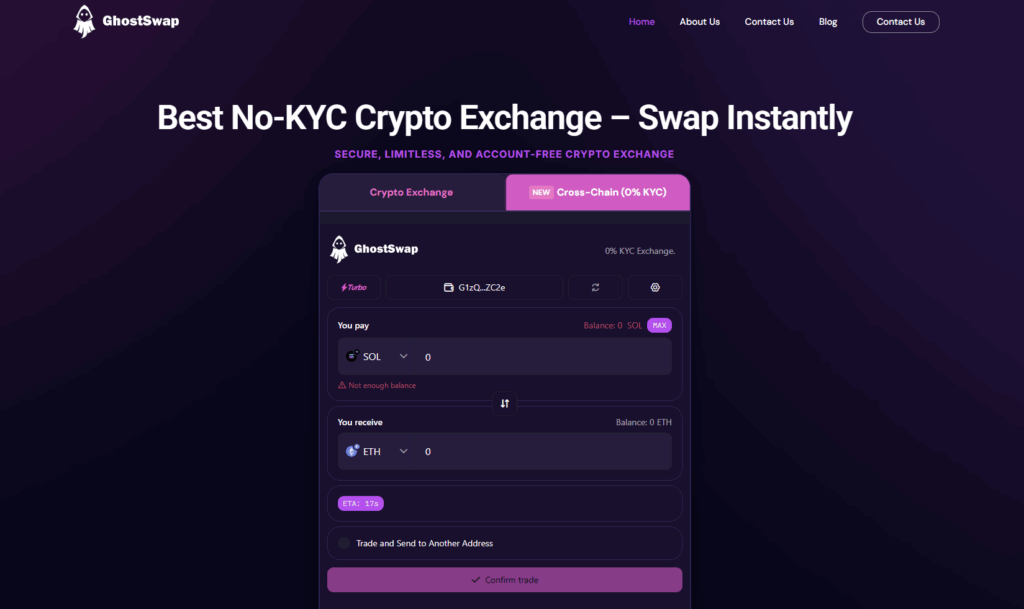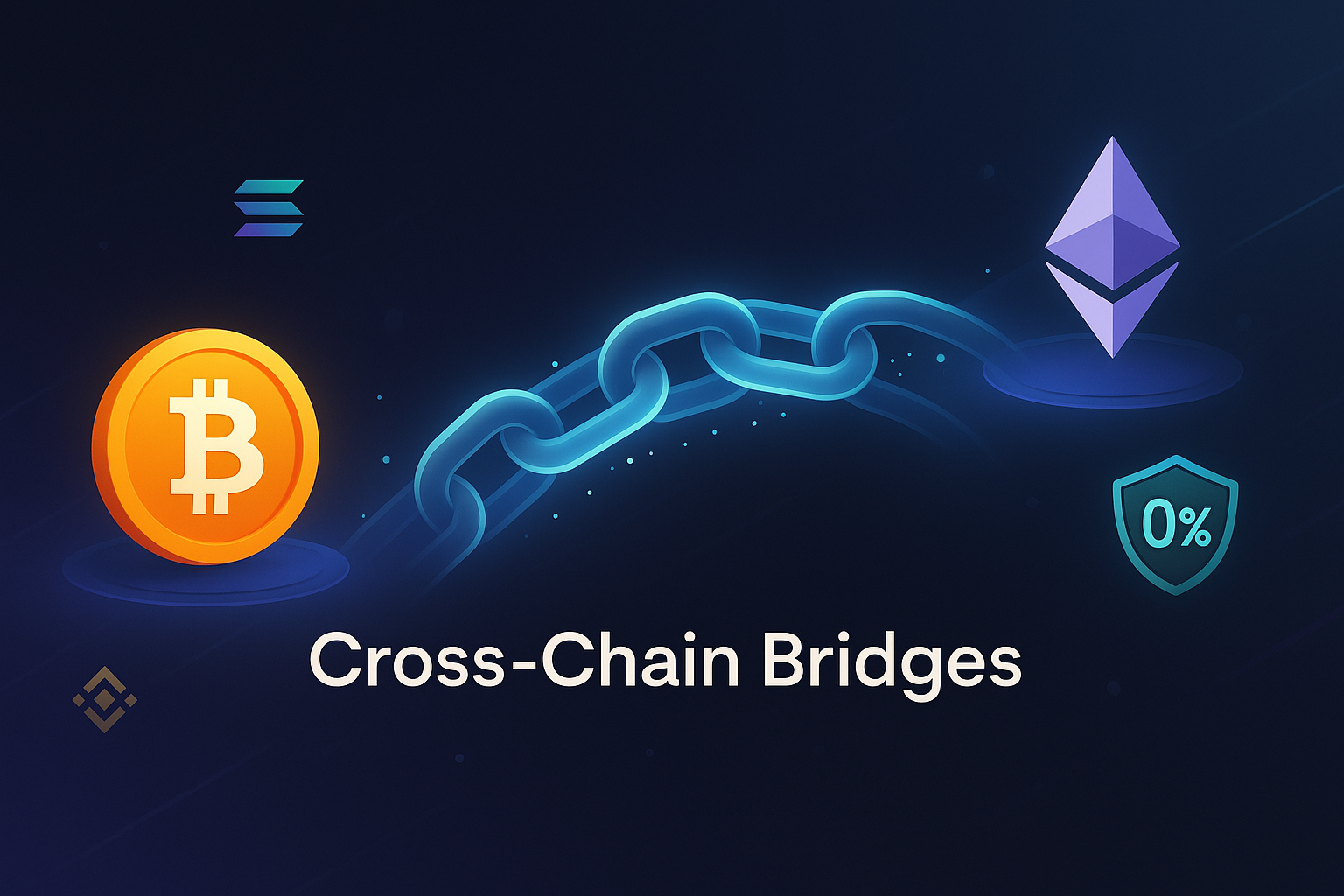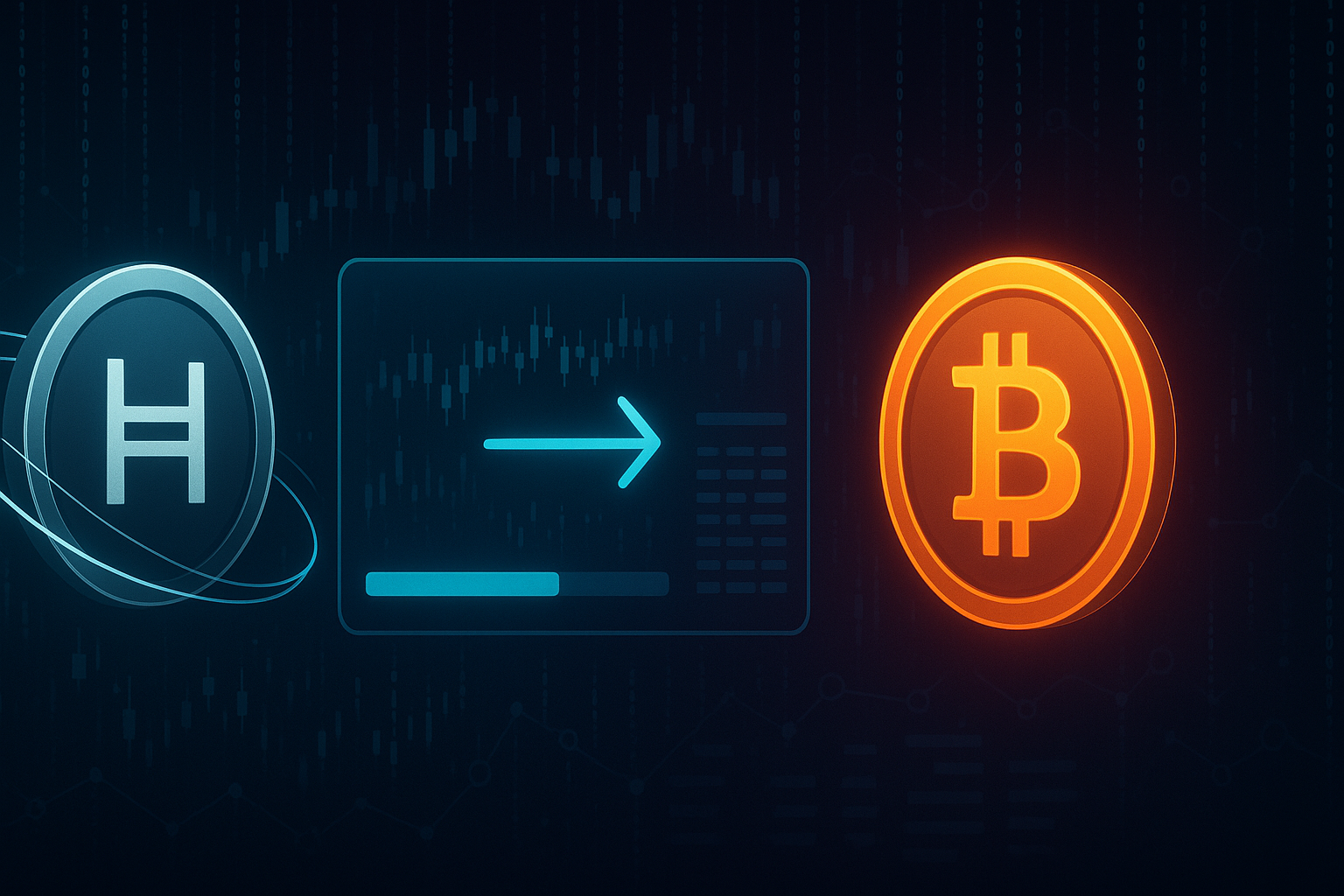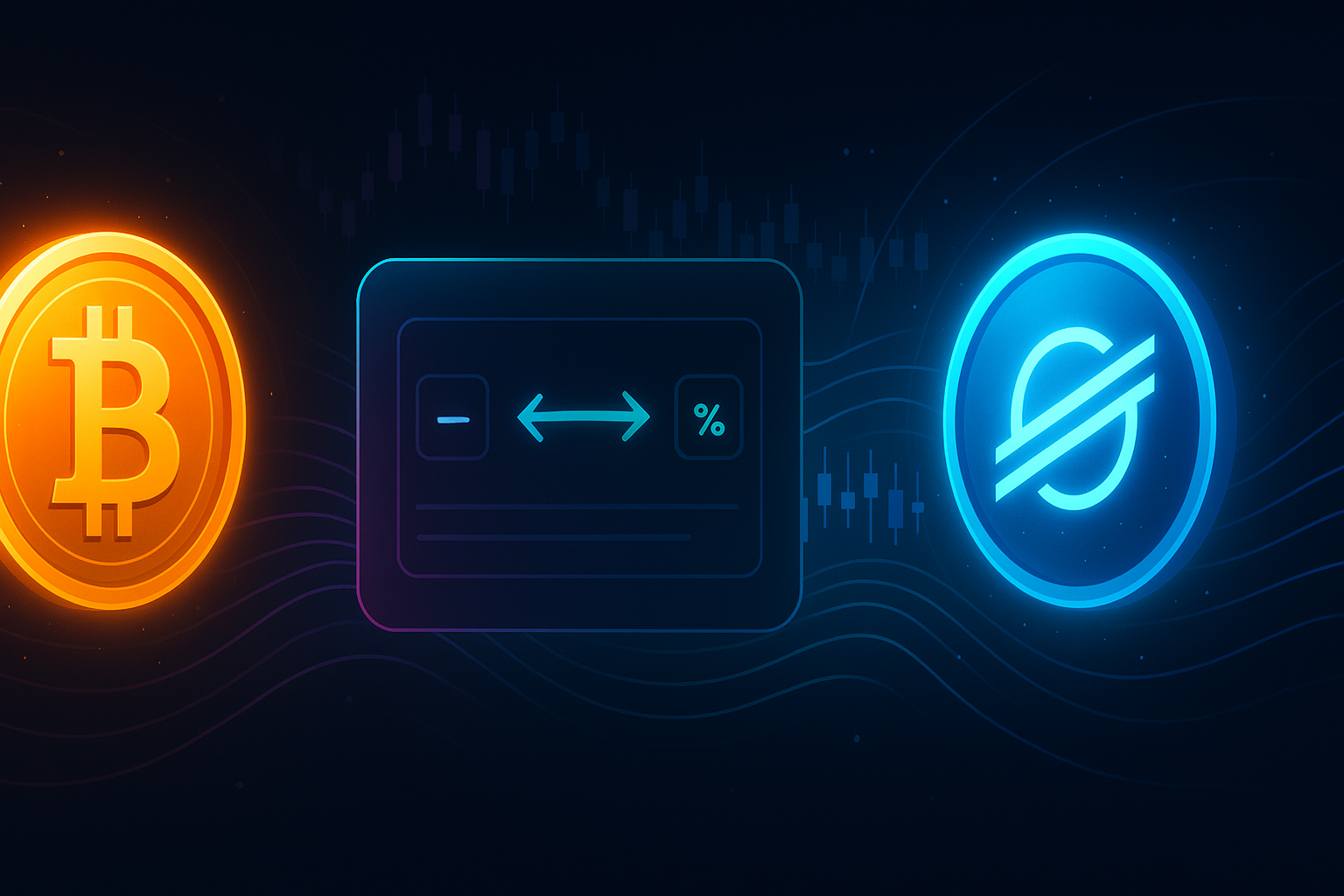Moving assets across blockchains used to mean cashing out on an exchange and re-buying on another network—slow, expensive, and full of friction. Cross-chain bridges solve this by letting you bridge crypto directly from one chain to another in minutes. In this guide, you’ll learn what cross-chain bridges are, how they work, why they’re safer and faster than legacy routes, and how to use two privacy-first options—GhostSwap and TorrentSwap—to bridge crypto with 0% KYC for crypto-to-crypto swaps.
What Is a Cross-Chain Bridge?
A cross chain bridge is an on-chain (or hybrid) system that enables assets to move from one blockchain to another. Instead of selling on Chain A and buying on Chain B, you initiate a single transaction that:
- Locks, routes, or swaps your asset on the source chain,
- Verifies the transfer via validators, light clients, or liquidity networks, and
- Releases or mints the equivalent asset on the destination chain.
Different designs power this flow:
- Liquidity-network bridges (liquidity pools on both chains)
- Router/aggregator bridges (pick the best path across multiple bridges/DEXes)
- Canonical bridges (chain-native bridges run by the ecosystem)
The end result: you bridge crypto directly with fewer steps, less risk, and more speed.
Why Use a Cross-Chain Bridge Instead of a CEX?
- Privacy & speed: For pure crypto-to-crypto moves, reputable bridges let you transfer with 0% KYC—no signup, no selfies—so you maintain privacy while moving fast.
- Lower friction: No deposit/withdrawal queues, no account approvals, no withdrawal limits imposed by centralized venues.
- Better execution: Router bridges can automatically search multiple routes for better fees, slippage, and time-to-finality.
- On-chain auditability: Transactions are transparent and verifiable on public explorers.
Note: Fiat on/off-ramps are different; those typically require KYC. But cross chain crypto-to-crypto bridging on platforms like GhostSwap or TorrentSwap is designed to be account-free.
Top Cross-Chain Bridge Options (Privacy-First)

1) GhostSwap — No-KYC Cross-Chain Swap & Bridge Aggregator (Recommended)
Link: https://ghostswap.io
GhostSwap focuses on private, cross-chain swaps without accounts. It aggregates DEXes/AMMs and cross-chain routers to surface efficient routes for popular pairs (e.g., bridge BTC to ETH, BTC↔BNB, ETH↔SOL, and many more). You connect a wallet, choose source/destination chains and assets, review the quoted route, and swap. No forms, no KYC—just bridge crypto end-to-end.
Why GhostSwap first?
- 0% KYC for crypto-to-crypto routes
- Router intelligence: scans multiple on-chain paths
- Clean UX: straightforward flow from asset selection to finality
2) TorrentSwap — Cross-Chain Bridge Built for Simplicity
Link: https://torrentswap.com
TorrentSwap offers a clean, privacy-friendly experience to bridge crypto across popular chains. It emphasizes simplicity: pick your from-chain and to-chain, select the asset, and execute. Like GhostSwap, the focus is on account-free crypto-to-crypto bridging, making cross chain moves quick and accessible.
How Cross-Chain Bridges Work (Plain English)
- You choose a route. The bridge or router finds a viable path (e.g., native bridge, liquidity network, or hybrid route).
- You approve and send. You sign a transaction from your wallet.
- Verification happens. Depending on the bridge design, relayers/validators/light-clients confirm the transfer.
- Funds arrive. You receive your asset on the destination chain (either the native token, a wrapped version, or the swapped equivalent).
Costs to expect: network gas, bridge/router fees, and potential DEX swap fees along the route. Router bridges often minimize these by comparing multiple options.
Step-by-Step: Bridge Crypto with GhostSwap
- Go to ghostswap.io.
- Connect your wallet. Use a supported wallet for your source chain.
- Choose “From” and “To.” Example: From Bitcoin to Ethereum (i.e., bridge BTC to ETH).
- Pick assets. Select the specific token (e.g., BTC → ETH).
- Enter amount. GhostSwap will surface a route with the estimated time, fees, and slippage.
- Review details. Double-check min received, bridge fee, gas, and any notes.
- Approve (if needed) & swap. Sign transactions in your wallet.
- Track progress. You can follow status on-chain and confirm when funds land on the destination chain.
Pro tips for GhostSwap
- Start with a small test amount when using a new cross chain route.
- Keep a little native gas token on the destination chain for future transactions.
- If you see an unusually high slippage, try alternative routes or reduce size.
Step-by-Step: Bridge Crypto with TorrentSwap
- Open TorrentSwap (site).
- Connect wallet on the source chain.
- Set From/To chains and choose the asset pair.
- Enter amount and preview the route/fees.
- Confirm & sign the transaction(s) in your wallet.
- Wait for confirmation and verify receipt on the destination chain’s block explorer.
Security & Best Practices for Cross-Chain Bridging
- Test first. Send a small amount to validate the route, address, and timing.
- Verify official URLs. Bookmark ghostswap.io and TorrentSwap’s official domain. Watch for look-alike phishing sites.
- Check contract addresses. If a wrapped token is involved, confirm it’s the official contract.
- Mind approvals. ERC-20 approvals persist. Periodically revoke unused allowances with a reputable tool.
- Set reasonable slippage. Too high can invite MEV; too low might cause failed swaps during volatility.
- Watch chain status. Congestion or degraded bridge relayers can slow finality; if timing is critical, pick a faster route even if fees are slightly higher.
- Use hardware wallets for larger amounts.
Fees, Speed, and Reliability: What to Expect
- Fees: network gas (both chains), plus bridge/router fees and any DEX leg. Router-style bridges help optimize for the lowest all-in cost.
- Speed: ranges from a minute to ~30+ minutes depending on confirmation depth, network load, and design (liquidity network vs. canonical).
- Reliability: Bridges have distinct trust models; using reputable, well-used routes and keeping amounts within pool liquidity limits improves outcomes.
When to Use a Cross-Chain Bridge
- DeFi opportunities: Move capital to the best yields on other networks.
- Gas optimization: Shift to chains with lower gas fees for frequent activity.
- NFT and ecosystem access: Join mints or dApps that live on a specific chain.
- Trading flexibility: Respond to market moves quickly by reallocating across chains.
- Airdrop prep: Some protocols consider cross chain presence in eligibility heuristics.
GhostSwap vs. TorrentSwap (Quick Comparison)
| Feature | GhostSwap | TorrentSwap |
|---|---|---|
| KYC for crypto-to-crypto | No (0% KYC) | No (0% KYC) |
| Model | Router/aggregator across DEXes & bridges | Simple, privacy-first bridging flow |
| UX | Route comparison, clear estimates | Minimal steps, beginner-friendly |
| When to choose | You want the best route and execution | You want a streamlined, no-distraction experience |
(Exact supported routes and assets evolve—always check the app for current availability.)
Frequently Asked Questions
Is cross-chain bridging safe?
It’s as safe as the route you choose. Established bridges and routers with strong security records and liquidity are preferable. Always test with small amounts and verify official domains/contracts.
Do I need KYC to bridge crypto?
For crypto-to-crypto bridging on platforms like GhostSwap and TorrentSwap, no—that’s 0% KYC. If you touch fiat (credit card buys, bank withdrawals), KYC usually applies.
How long does it take to bridge crypto?
From under a minute to ~30 minutes+, depending on chains, route, and congestion. Routers try to pick paths that balance speed, fees, and reliability.
What fees will I pay?
Gas on both chains, plus bridge/router fees and any swap fees. Router bridges often reduce total cost by selecting efficient paths.
What’s the difference between a bridge and a router/aggregator?
A bridge is a specific pathway between chains; a router/aggregator compares many bridges/DEXes to find the best overall route for your transfer.
Can I bridge BTC to ETH?
Yes—use GhostSwap to bridge BTC to ETH (and many other pairs). Connect your wallet, choose the networks/assets, review the quote, and swap.
SEO Tips If You’re Publishing This Guide
- Title tag: “Cross-Chain Bridges in 2025: How to Bridge Crypto Fast (0% KYC)”
- Meta description: “Learn how cross-chain bridges let you bridge crypto across networks with 0% KYC for crypto-to-crypto. Step-by-step guides for GhostSwap and TorrentSwap.”
- H1: Use a phrase with cross chain and bridge crypto.
- Internal linking: Link to your other how-to guides (e.g., “bridge BTC to ETH,” “bridge ETH to SOL”).
- FAQ schema: Mark up the FAQ to earn rich results.
- Image alt text: e.g., “Cross-chain bridge flow diagram,” “How to bridge crypto with GhostSwap.”
Ready to Bridge Crypto?
- Start with GhostSwap (Recommended): ghostswap.io — 0% KYC for crypto-to-crypto, router intelligence, fast execution.
- Try TorrentSwap: (site) — simple, privacy-first cross chain experience.
With the right tools, cross-chain moves are fast, private, and cost-efficient. Skip the centralized detours—bridge crypto directly and stay in control.





